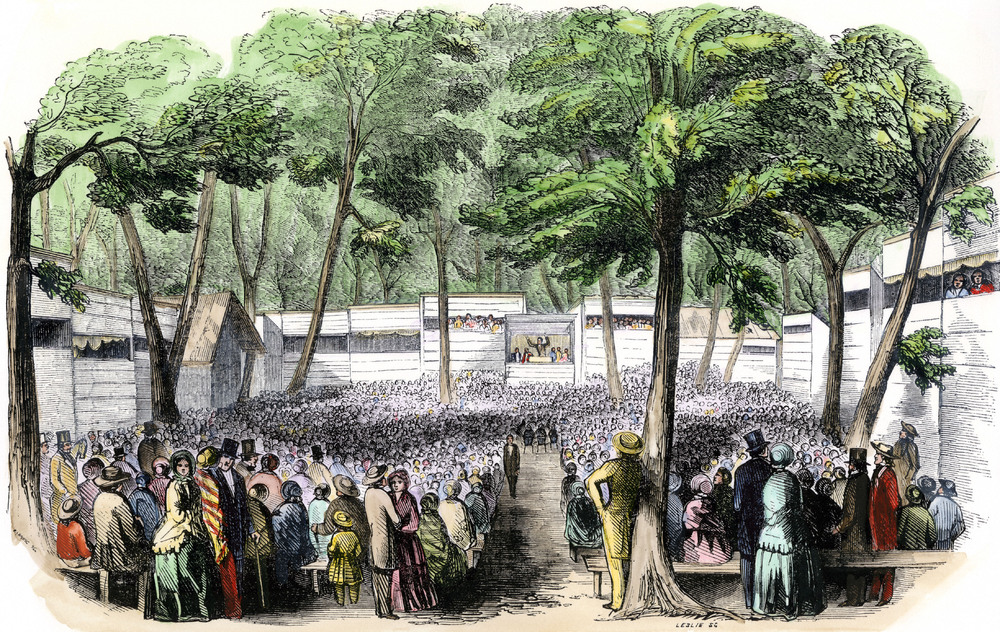Duck Creek Camp Meeting
Early, annual Methodist gathering with both white and Black participants

Sometime in the early 1840’s, Cincinnati’s Methodists began conducting large, annual camp meetings just south of Madisonville, on Duck Creek. These meetings were attended by as many as 3,000 people and would last for a week or more. Many of the attendees were Black.
In 1865, an article appeared in the New York Times (quoting the Cincinnati Times) about the early history of this camp meeting. The article states, “With the second year of the occupation of the Duck Creek grounds, it was found necessary to apportion the grounds to accommodate the increased attendance. The German and African congregations claimed a representation, and the demand was imperative.”
Still, while African Americans had “claimed a representation, and the demand was imperative,” the response by white organizers suggests a high level of segregation. The 1865 account continues: “Accordingly one quarter [of the site] was assigned to the colored members, another to the German, while the English or Americans formed the main center.”
An 1852 article in Gleason’s Pictorial Drawing Room Companion included an engraving of the Duck Creek Camp Meeting and reported that, “The encampment consists of a principal square for preaching in the English language, and a smaller square at a convenient distance to the south for the Germans.” A third stage for preaching was located in the African American area.
Each stage was surrounded by rows of semi-permanent “tents,” which were wood-framed structures, often with a second floor, covered in canvas. These “tents” were where the attendees lived during the week of the meeting. Narrow streets separated additional rows of tents, so that there was enough space to “furnish lodging for about three thousand persons.” The housing was racially segregated, with the tents for the Germans on their square to the south, “while the people of color have tents on the north.”
Presumably, many of the preachers in the African American area were Black, but so far, none of their names has come to light. The only preacher known to have spoken regularly from that platform was a white Methodist minister, Rev. George W. Maley. Maley was plain spoken and personable. Many white attendees would forsake the main stage and come to the African American area to hear Maley speak. The 1865 account, recalling years long past, says,
“The African portion was variously supplied [by speakers], but never so happily as when Rev. Geo. Maley was called upon to occupy the pulpit. … How well he preached, and how many of his white brethren left the more highly finished orators to listen to his discourses, will long be remembered by those who retain a knowledge of the Duck Creek camp-ground, as it was in 1846. His were the denunciations of transgression which caused a shaking among the dry bones, and set up many an 'amen' from the scores of his earnest listeners.”
The Duck Creek Camp meeting was held in a grove of beech trees on the old Joseph Ward farm, south of what is now Erie Avenue, and west of what is now Red Bank Road.
In 1847, the trustees of the camp meeting signed a 10-year lease for 25 acres of property on the Ward farm at $100 per year. And during that decade, Cincinnati's Methodists advanced, at least haltingly, on a path toward racial justice. During the 1850's, minutes of the annual conferences of Cincinnati's Methodists encouraged resistance to the 1850 Fugitive Slave Act, and in 1856, Cincinnati's Methodists supported the founding of Wilberforce University, a historically Black institution.
Around 1857, after the lease on the Ward property expired, the Methodists moved their annual camp meeting to a place on Colerain Pike. But it was never as popular there as it had been in Madisonville.
The meeting was moved back to Duck Creek once, in 1865. The organizers promised “that there will be more tents and habitable attendants at this meeting than ever before at any preceding one held in this county.” But after that, the Duck Creek Camp Meeting seems to have disappeared.
Images
